The first thing that hits you isn’t a character or a line of dialogue. It’s a sunrise.
A soft hum rises into a roar, and before you know it, “Circle of Life” fills the room. If you were a kid in 1994, you probably sat cross-legged on the carpet, clutching a bowl of cereal, and felt goosebumps you didn’t have words for yet. The Lion King wasn’t just another Disney cartoon. It was the one that made you feel small in the best possible way, as if you were staring into something both ancient and brand new.
Fast forward to 2019, and the same sun rose again.
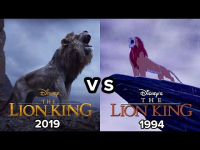
This time it came through photo-realistic CGI. The remake was stunning to look at, like watching a wildlife documentary where the animals broke into song. But for many of us, that hand-drawn magic from 1994 had already burned itself into memory.
The remake may have flexed Disney’s tech muscles, but the original carried the emotional weight that rewired our childhood brains.
That’s why The Lion King is more than a movie. It’s a story that keeps circling back into our lives.
From worn-out VHS tapes to Broadway stages, from sing-along car rides to billion-dollar remakes, it shows how Disney’s Circle of Life hasn’t stopped spinning. And like we saw when revisiting Harry Potter, Barney, or Indian in the Cupboard, some stories don’t just stay in the past. They grow with us.
You feel it in your chest before you know the words. “Nants ingonyama…” and the room lifts with “Circle of Life.” If you were a kid, you probably watched from the floor with a cold spoon in warm cereal. You did not blink when Rafiki raised Simba. You waited for that shot like a ritual.
What made 1994 hit so hard?
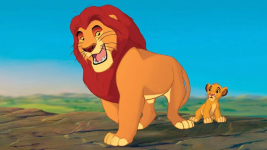
Image credit: MentalFloss
Color and character. The animation breathed in big strokes.
Skies felt painted, not printed. Lions talked with elastic faces that told you the feeling before the line arrived. That mattered. Exaggeration makes emotion easy to read. Your brain got the story in a heartbeat, then the dialogue caught up.
The music sealed it. Elton John and Tim Rice gave you hooks that stuck.
Hans Zimmer’s score moved like wind over tall grass. Drums underfoot. A choir like sunrise. You could not explain it, but you knew this cartoon felt important.
At home, the VHS lived on the shelf you could reach.
The case never closed right after the tenth watch. You rewound to Pride Rock like a homing pigeon. When we revisited Harry Potter on GeezeZone, we talked about first chapters that open doors. The Lion King did that in one song. It let you step into a world that felt ancient and brand new in the same breath.
Here is the quiet truth. The plot is classic.
A prince loses a father, runs from guilt, learns his name, returns. It is myth in simple lines. But the telling is what crowned it. The jokes landed without breaking the spell. Timon and Pumbaa slid in like a breath after a cry. You laughed. You kept moving.
Do you remember the first time the title hit the screen and the drum thumped like a heartbeat?
I do. I remember the hush that followed. The room made sense again, even if I was too young to say why. That is why 1994 became the one. It was not just a movie. It was a feeling you could replay.
The herd started to rumble like distant drums. Then the canyon turned into a river of hooves. Every kid I knew gripped the edge of the seat at the same moment. The gasp came early. The silence came later.
This is where the story shows its bones.
A jealous uncle, a trusting son, a father who chooses love over safety. It is Hamlet in the savanna, trimmed to its cleanest lines. Scar gives us the chill that great villains always do. His voice slides like a shadow across the rock. His plan feels clever until it looks like cowardice. “Long live the king” hits like a door slamming shut.
The stampede is the moral earthquake. Disney did not flinch from grief.
It put loss in the center and let kids sit with it. That mattered. Because the film also gives you a path out. Guilt, escape, drifting. Then new friends who offer a simple idea that is bigger than it sounds. Hakuna Matata is not denial. It is a bridge.
Timon and Pumbaa are the soft landing after a hard fall.
They let the story breathe without breaking it. Jokes arrive, but the wound is still there. That balance is why the movie ages well. It teaches you that laughter can sit next to sorrow without canceling it.
Now slide this scene beside 2019.
The remake makes the canyon look real. Dust hangs in the air. Fur ripples. Your eyes say, this could be nature footage. The tradeoff shows up in Scar. Chiwetel Ejiofor plays him colder, more clipped, less theatrical than Jeremy Irons. The menace is there, but it is a different flavor. You admire the realism. You miss the operatic sneer.
The biggest shift is facial expression.
Hand-drawn faces can stretch, squint, and crack. You read emotion instantly. The photoreal lions keep to nature’s limits. Subtle eye flickers do the work. It feels true to biology. It asks more of the viewer. In the stampede, that means the shock is visual, while the ache is quieter.
When we wrote about Indian in the Cupboard, we said the magic felt human because you could see the seams. The Lion King proves it again. Imperfection lets emotion breathe. The 1994 scene leaves you with a lump in the throat and a lesson in your pocket. The 2019 scene leaves you impressed and a step further back. Both land. One lingers.
That was the first thought when 2019 opened on the savanna. The light felt like late afternoon in July. Dust curled off hooves in tiny spirals. It was gorgeous, the kind of craft that makes you lean forward.
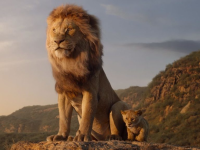
Image Credit: Disney
Jon Favreau’s approach was faithful. Shot for shot in places, melody for melody in others.
The technology pulled you into a world that looked like a documentary, then asked you to accept singing lions. For many viewers, that trust fall worked. For others, the leap felt longer than expected.
Performance changed with the fur. Hand-drawn Simba had eyebrows that could climb a mile.
Photoreal Simba had muscles that twitched and eyes that did the talking. Subtlety took the lead. You listened harder for emotion. You watched for tiny shifts in gaze. That can be rewarding, but it also moves some feeling from the face to the soundtrack and the memory you bring with you.
The cast brought its own weather. Donald Glover’s Simba felt cooler and more contemplative.
Beyoncé’s Nala had steel, plus a new anthem, “Spirit,” that slid in like a modern prayer. Chiwetel Ejiofor’s Scar was clipped and dangerous, less theatrical than Jeremy Irons, more coiled spring than purring showman. Timon and Pumbaa leaned into drier humor, the kind you catch on the second watch.
What did we gain?
Scale, texture, a museum-grade diorama come to life. What did we lose?
The shorthand of big expressions, the stagey flair that lets kids read a face in half a second. In our Short Circuit and Indian in the Cupboard pieces, we kept circling the same idea. Imperfection can be an invitation. It asks your brain to fill in the gaps, and that is where a lot of the magic hides.
Here is where both films meet again.
The themes survive the format. Loss, wandering, return, responsibility. When Mufasa’s voice calls from the clouds, both versions ask you the same question. Who are you, really, when no one is looking? That question is bigger than fur or ink.
Do you remember your first watch of the remake?
I remember admiring the craft and realizing, by the end, that the 1994 feelings were the light I was using to see it. That is not a failure. That is how nostalgia works. It layers the new on top of the old and asks them to sing.
Big eyes, bold colors, melodies that carry meaning before a lyric lands. The 2019 film tells a seen truth. Fur that catches wind, dust that hangs, animal motion that obeys gravity. Both can move you. They just take different roads.
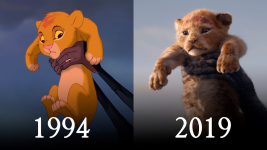
Emotion reads fast in hand-drawn lines.
A smirk arcs higher, a tear glints bigger, a jaw drops wider. Kids catch it instantly. Adults do too. Photoreal lions live inside nature’s range. Feelings arrive in smaller signals. A longer blink. A held breath. A drop in the voice. That can feel more lifelike. It can also feel quieter than your memory expects.
Music bridges the gap. “Circle of Life” works like a memory shortcut.
The first chord pulls you back to a place on the living room rug. The remake respects that pull. It also adds “Spirit,” which brings a modern lift and gives Nala more presence. You can love both moments. One is nostalgia’s welcome mat. The other is a new door.
Humor shifts as well.
1994 lets Timon and Pumbaa bounce like rubber balls. Jokes arrive with cartoon timing. 2019 moves to drier banter and mock-documentary beats. You smile more than you cackle. It suits the look. It changes the rhythm.
What did we gain?
A visual marvel, a proof that the circle can spin inside cutting-edge craft. What did we lose?
The speed of connection that stylization buys you. When we wrote about Indian in the Cupboard, we said seams can be part of the spell. When we covered Barney, we saw how simplicity makes songs sticky. The Lion King sits where those ideas meet. Stylization helps feelings fly. Realism helps worlds feel solid. The sweet spot is where your heart accepts both.
Here is my small confession.
I reach for 1994 when I want to feel the old ache and the quick lift. I reach for 2019 when I want to marvel at how far the tools have come. Both viewings end at the same place. Remember who you are. Step back into the light.
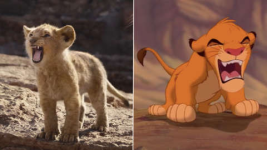
After the canyon, he runs from the name he was born to carry, then grows into it the hard way. That arc is why the story sticks. You watch a boy become a king by facing what hurts.
In 1994 his face reads like a book. Big eyes, quick smiles, fear you can spot from the doorway.
In 2019 he is quieter and more internal. You look for the feeling in tiny eye flickers and the way his voice softens. Think of Prince Zuko in Avatar. The best coming of age stories are really reckonings. Simba stands with them.
Hakuna Matata is his detour, not his destiny. The lesson lands when he looks up and listens. Remember who you are is not just fatherly poetry. It is a call to show up for your people, even when you feel small. I still get a chill when he climbs Pride Rock in the rain.
He is the kind of dad who teaches by walking into the dark first. The hyena chase sets the tone. Power is service. Courage is for the ones behind you.
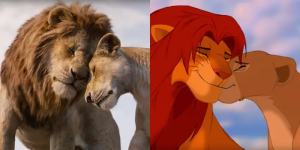
His warmth makes the fall hit harder.
When he says everything the light touches, you feel the promise and the responsibility in the same breath. In 2019 the photoreal look makes him feel like a true apex predator. In 1994 the animation lets his smile glow a little brighter. Both versions give you the father you wish every prince, or kid, could have.
Stack him next to Stoick from How to Train Your Dragon or King Triton from The Little Mermaid.
All three are guardians whose love is larger than their rules. The difference is the spiritual echo. Mufasa does not just leave advice. He becomes the voice that points you home when the clouds roll in.

As an adult she becomes the conscience of the story. She sees the Pride Lands dying and decides to act. That quiet courage is her signature.
In 1994 Nala’s power shows in the eyes and in the way she pins Simba with a playful flip that turns serious later.
In 2019 she gets more space. Her hunt is tense, her escape is daring, and “Spirit” adds a modern lift to her journey. Think of Katara in Avatar. Both are empathetic fighters who push the hero to grow up. When Nala says the kingdom needs you, it feels like the line that turns the key.
She is not a side note. She is the reason the story shifts from hiding to homecoming. If Simba is the heart, Nala is the heartbeat that will not let him sleep through the alarm.

As the foil to Mufasa’s warmth, he is a master class in envy. The lair, the green glow, the marching hyenas, it all plays like a smoky jazz number that turns into a threat.
Jeremy Irons in 1994 gives Scar a theatrical purr that you can quote by memory.
Chiwetel Ejiofor in 2019 sharpens him into something colder, more clipped, closer to a coiled knife. Both work. One feels like a stage villain who relishes every word.
The other feels like a calculating predator. Line him up beside Shere Khan from The Jungle Book or Jafar from Aladdin. They all weaponize language before claws. Scar’s edge is personal. He wants the crown and your belief that he deserves it.
What makes him stick is the smallness underneath the plotting. Scar is what happens when a clever mind decides that love is a rigged game. That is why his final fall feels inevitable. He never learns what Mufasa knew from the start. Real power serves.

When he meets Simba, he offers the simplest medicine a hurting kid can swallow. Food. Friends. A day without the word destiny
In 1994, Timon moves like elastic. Jokes bounce, shoulders shrug, and you can almost see the thought bubbles.
In 2019, the humor leans drier, closer to nature-doc riffing. Both flavors work because Timon’s role is rhythm. He shifts the film from grief to motion. Think of Donkey in Shrek. Same job, different music.
Keep the hero laughing just enough to keep moving.
What sneaks up on you is his loyalty. When the Pride Lands need help, Timon stops running and stands up. The clown turns into a friend you can count on.
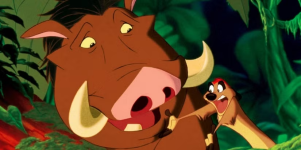
That makes his bravery hit twice as hard. He finds a lost cub in the desert and says, let’s help him. No questions. That is who he is.
In 1994 he is pure warmth.
In 2019 he keeps the warmth and adds a little earthy realism. You hear the heft in his voice. The banter with Timon tightens up, but the soul stays the same. If Timon is the spark, Pumbaa is the steady flame. Compare him to Baymax from Big Hero 6. Both are gentle protectors who turn comic relief into emotional ballast.
Hakuna Matata is their gift, but their bigger gift is time. They hold space until Simba can hear Mufasa again. That is friendship at work.
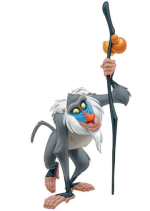
He laughs at the wrong time, talks in riddles, and somehow lands the one lesson the hero needs. He is not the mentor who lectures. He is the guide who nudges you to look in the right direction. The fruit, the staff, the paint on Simba’s brow, every gesture feels like a small ceremony.
In 1994 he moves like a windblown monk. Quick, springy, always one hop ahead.
In 2019 he feels more grounded, less acrobat, more sage, and the staff carries more weight. Think of Uncle Iroh in Avatar. Both are gentle teachers who turn tea and proverbs into turning points. Rafiki’s best trick is the simplest one. He holds up the mirror and says, remember who you are. No sermon. Just truth.

The Pride Lands are big, and he is the clipboard trying to keep it all tidy. That makes him funny, because nothing in this story stays tidy for long.
In 1994 he flutters and fusses with perfect comic timing.
In 2019 the realism makes him less rubbery, but the wit sharpens. His lines land like little darts. Stack him next to Cogsworth from Beauty and the Beast. Both are fussy stewards who care more than they let on. Zazu complains because he wants the kingdom safe. When the chips are down, he is brave in his own exact way
He is also a good reminder that not every hero roars. Some keep the ledger, keep the watch, and keep showing up.

After the stampede, she becomes the spine of the pride. Food is gone, hope is thin, and she still holds the lines together. That steadiness is its own kind of heroism.
In 1994 you feel her warmth and resolve in the way she carries herself. In 2019 her stare could cut stone. She challenges Scar in front of everyone and does not flinch. Place her next to Queen Elinor from Brave. Both are mothers who rule with presence more than volume. Sarabi shows that leadership can be calm, firm, and unshakeable.
When Simba returns, her relief is small and true. No speech.
Just a mother seeing her child step into his name. That moment still lands.
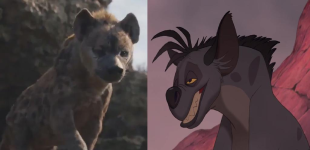
In 1994 she is wisecracking and street smart, the voice that keeps the pack from tripping over its own paws. In 2019 she gets more weight and menace, a war-leader who treats the Pride Lands like territory, not a buffet.
Compare her to Azula’s lieutenants in Avatar or Shego in Kim Possible.
Loyal when it pays, dangerous when cornered. What makes Shenzi interesting is the line she walks between comic foil and real threat. Under Scar she becomes the muscle behind a broken kingdom. When the tide turns, she reads the room faster than anyone and makes a hard choice.
She is proof that even side villains can carry texture. Hunger, humor, hierarchy. All three live in her scenes.
1994 gave us the rush of big feelings you could read from across the room. 2019 gave us texture and awe you could almost touch. Put them together and you get the simple truth this story keeps singing. Loss, wandering, return, responsibility.
We have discussed this before. Harry Potter built a bigger world. Indian in the Cupboard made magic feel close. Barney turned songs into glue. The Lion King does all three in its own style. It grows. It stays near. It sticks.
So, keep the tape on the shelf or the tile in your queue. Share the songs in the car. Let the stampede knock the wind out of you, and the rain on Pride Rock put it back. The circle is not just on screen. It is in how we pass these stories along.
Remember who you are. Then climb.
What do you remember about The Lion King? Post your comment below.
A soft hum rises into a roar, and before you know it, “Circle of Life” fills the room. If you were a kid in 1994, you probably sat cross-legged on the carpet, clutching a bowl of cereal, and felt goosebumps you didn’t have words for yet. The Lion King wasn’t just another Disney cartoon. It was the one that made you feel small in the best possible way, as if you were staring into something both ancient and brand new.
Fast forward to 2019, and the same sun rose again.

This time it came through photo-realistic CGI. The remake was stunning to look at, like watching a wildlife documentary where the animals broke into song. But for many of us, that hand-drawn magic from 1994 had already burned itself into memory.
The remake may have flexed Disney’s tech muscles, but the original carried the emotional weight that rewired our childhood brains.
That’s why The Lion King is more than a movie. It’s a story that keeps circling back into our lives.
From worn-out VHS tapes to Broadway stages, from sing-along car rides to billion-dollar remakes, it shows how Disney’s Circle of Life hasn’t stopped spinning. And like we saw when revisiting Harry Potter, Barney, or Indian in the Cupboard, some stories don’t just stay in the past. They grow with us.
How The Lion King (1994) Became “The One”
The screen glows orange. A single call cuts the quiet.You feel it in your chest before you know the words. “Nants ingonyama…” and the room lifts with “Circle of Life.” If you were a kid, you probably watched from the floor with a cold spoon in warm cereal. You did not blink when Rafiki raised Simba. You waited for that shot like a ritual.
What made 1994 hit so hard?

Image credit: MentalFloss
Color and character. The animation breathed in big strokes.
Skies felt painted, not printed. Lions talked with elastic faces that told you the feeling before the line arrived. That mattered. Exaggeration makes emotion easy to read. Your brain got the story in a heartbeat, then the dialogue caught up.
The music sealed it. Elton John and Tim Rice gave you hooks that stuck.
Hans Zimmer’s score moved like wind over tall grass. Drums underfoot. A choir like sunrise. You could not explain it, but you knew this cartoon felt important.
At home, the VHS lived on the shelf you could reach.
The case never closed right after the tenth watch. You rewound to Pride Rock like a homing pigeon. When we revisited Harry Potter on GeezeZone, we talked about first chapters that open doors. The Lion King did that in one song. It let you step into a world that felt ancient and brand new in the same breath.
Here is the quiet truth. The plot is classic.
A prince loses a father, runs from guilt, learns his name, returns. It is myth in simple lines. But the telling is what crowned it. The jokes landed without breaking the spell. Timon and Pumbaa slid in like a breath after a cry. You laughed. You kept moving.
Do you remember the first time the title hit the screen and the drum thumped like a heartbeat?
I do. I remember the hush that followed. The room made sense again, even if I was too young to say why. That is why 1994 became the one. It was not just a movie. It was a feeling you could replay.
The Myth Inside The Lion King Film
You felt the storm before you saw it. The sky went bruised purple.This is where the story shows its bones.
A jealous uncle, a trusting son, a father who chooses love over safety. It is Hamlet in the savanna, trimmed to its cleanest lines. Scar gives us the chill that great villains always do. His voice slides like a shadow across the rock. His plan feels clever until it looks like cowardice. “Long live the king” hits like a door slamming shut.
The stampede is the moral earthquake. Disney did not flinch from grief.
It put loss in the center and let kids sit with it. That mattered. Because the film also gives you a path out. Guilt, escape, drifting. Then new friends who offer a simple idea that is bigger than it sounds. Hakuna Matata is not denial. It is a bridge.
Timon and Pumbaa are the soft landing after a hard fall.
They let the story breathe without breaking it. Jokes arrive, but the wound is still there. That balance is why the movie ages well. It teaches you that laughter can sit next to sorrow without canceling it.
Now slide this scene beside 2019.
The remake makes the canyon look real. Dust hangs in the air. Fur ripples. Your eyes say, this could be nature footage. The tradeoff shows up in Scar. Chiwetel Ejiofor plays him colder, more clipped, less theatrical than Jeremy Irons. The menace is there, but it is a different flavor. You admire the realism. You miss the operatic sneer.
The biggest shift is facial expression.
Hand-drawn faces can stretch, squint, and crack. You read emotion instantly. The photoreal lions keep to nature’s limits. Subtle eye flickers do the work. It feels true to biology. It asks more of the viewer. In the stampede, that means the shock is visual, while the ache is quieter.
When we wrote about Indian in the Cupboard, we said the magic felt human because you could see the seams. The Lion King proves it again. Imperfection lets emotion breathe. The 1994 scene leaves you with a lump in the throat and a lesson in your pocket. The 2019 scene leaves you impressed and a step further back. Both land. One lingers.
2019 Arrives: Real Animals, Real Dust, Real Debate
You could count the whiskers.That was the first thought when 2019 opened on the savanna. The light felt like late afternoon in July. Dust curled off hooves in tiny spirals. It was gorgeous, the kind of craft that makes you lean forward.

Image Credit: Disney
Jon Favreau’s approach was faithful. Shot for shot in places, melody for melody in others.
The technology pulled you into a world that looked like a documentary, then asked you to accept singing lions. For many viewers, that trust fall worked. For others, the leap felt longer than expected.
Performance changed with the fur. Hand-drawn Simba had eyebrows that could climb a mile.
Photoreal Simba had muscles that twitched and eyes that did the talking. Subtlety took the lead. You listened harder for emotion. You watched for tiny shifts in gaze. That can be rewarding, but it also moves some feeling from the face to the soundtrack and the memory you bring with you.
The cast brought its own weather. Donald Glover’s Simba felt cooler and more contemplative.
Beyoncé’s Nala had steel, plus a new anthem, “Spirit,” that slid in like a modern prayer. Chiwetel Ejiofor’s Scar was clipped and dangerous, less theatrical than Jeremy Irons, more coiled spring than purring showman. Timon and Pumbaa leaned into drier humor, the kind you catch on the second watch.
What did we gain?
Scale, texture, a museum-grade diorama come to life. What did we lose?
The shorthand of big expressions, the stagey flair that lets kids read a face in half a second. In our Short Circuit and Indian in the Cupboard pieces, we kept circling the same idea. Imperfection can be an invitation. It asks your brain to fill in the gaps, and that is where a lot of the magic hides.
Here is where both films meet again.
The themes survive the format. Loss, wandering, return, responsibility. When Mufasa’s voice calls from the clouds, both versions ask you the same question. Who are you, really, when no one is looking? That question is bigger than fur or ink.
Do you remember your first watch of the remake?
I remember admiring the craft and realizing, by the end, that the 1994 feelings were the light I was using to see it. That is not a failure. That is how nostalgia works. It layers the new on top of the old and asks them to sing.
Then vs Now: What We Gained, What We Lost
Lay the two films side by side and you see two kinds of truth. The 1994 film tells a felt truth.Big eyes, bold colors, melodies that carry meaning before a lyric lands. The 2019 film tells a seen truth. Fur that catches wind, dust that hangs, animal motion that obeys gravity. Both can move you. They just take different roads.

Emotion reads fast in hand-drawn lines.
A smirk arcs higher, a tear glints bigger, a jaw drops wider. Kids catch it instantly. Adults do too. Photoreal lions live inside nature’s range. Feelings arrive in smaller signals. A longer blink. A held breath. A drop in the voice. That can feel more lifelike. It can also feel quieter than your memory expects.
Music bridges the gap. “Circle of Life” works like a memory shortcut.
The first chord pulls you back to a place on the living room rug. The remake respects that pull. It also adds “Spirit,” which brings a modern lift and gives Nala more presence. You can love both moments. One is nostalgia’s welcome mat. The other is a new door.
Humor shifts as well.
1994 lets Timon and Pumbaa bounce like rubber balls. Jokes arrive with cartoon timing. 2019 moves to drier banter and mock-documentary beats. You smile more than you cackle. It suits the look. It changes the rhythm.
What did we gain?
A visual marvel, a proof that the circle can spin inside cutting-edge craft. What did we lose?
The speed of connection that stylization buys you. When we wrote about Indian in the Cupboard, we said seams can be part of the spell. When we covered Barney, we saw how simplicity makes songs sticky. The Lion King sits where those ideas meet. Stylization helps feelings fly. Realism helps worlds feel solid. The sweet spot is where your heart accepts both.
Here is my small confession.
I reach for 1994 when I want to feel the old ache and the quick lift. I reach for 2019 when I want to marvel at how far the tools have come. Both viewings end at the same place. Remember who you are. Step back into the light.
The Lion King Characters
Simba
Simba starts as a curious cub who wants the crown for the fun of it.
After the canyon, he runs from the name he was born to carry, then grows into it the hard way. That arc is why the story sticks. You watch a boy become a king by facing what hurts.
In 1994 his face reads like a book. Big eyes, quick smiles, fear you can spot from the doorway.
In 2019 he is quieter and more internal. You look for the feeling in tiny eye flickers and the way his voice softens. Think of Prince Zuko in Avatar. The best coming of age stories are really reckonings. Simba stands with them.
Hakuna Matata is his detour, not his destiny. The lesson lands when he looks up and listens. Remember who you are is not just fatherly poetry. It is a call to show up for your people, even when you feel small. I still get a chill when he climbs Pride Rock in the rain.
Mufasa
Mufasa is strength without noise. He moves like a mountain and talks like a drum.He is the kind of dad who teaches by walking into the dark first. The hyena chase sets the tone. Power is service. Courage is for the ones behind you.

His warmth makes the fall hit harder.
When he says everything the light touches, you feel the promise and the responsibility in the same breath. In 2019 the photoreal look makes him feel like a true apex predator. In 1994 the animation lets his smile glow a little brighter. Both versions give you the father you wish every prince, or kid, could have.
Stack him next to Stoick from How to Train Your Dragon or King Triton from The Little Mermaid.
All three are guardians whose love is larger than their rules. The difference is the spiritual echo. Mufasa does not just leave advice. He becomes the voice that points you home when the clouds roll in.
Nala
Nala is resolve in a soft voice. As a cub she matches Simba step for step, fearless and curious.
As an adult she becomes the conscience of the story. She sees the Pride Lands dying and decides to act. That quiet courage is her signature.
In 1994 Nala’s power shows in the eyes and in the way she pins Simba with a playful flip that turns serious later.
In 2019 she gets more space. Her hunt is tense, her escape is daring, and “Spirit” adds a modern lift to her journey. Think of Katara in Avatar. Both are empathetic fighters who push the hero to grow up. When Nala says the kingdom needs you, it feels like the line that turns the key.
She is not a side note. She is the reason the story shifts from hiding to homecoming. If Simba is the heart, Nala is the heartbeat that will not let him sleep through the alarm.
Scar
Scar is charm with teeth. He talks like velvet, then cuts like glass.
As the foil to Mufasa’s warmth, he is a master class in envy. The lair, the green glow, the marching hyenas, it all plays like a smoky jazz number that turns into a threat.
Jeremy Irons in 1994 gives Scar a theatrical purr that you can quote by memory.
Chiwetel Ejiofor in 2019 sharpens him into something colder, more clipped, closer to a coiled knife. Both work. One feels like a stage villain who relishes every word.
The other feels like a calculating predator. Line him up beside Shere Khan from The Jungle Book or Jafar from Aladdin. They all weaponize language before claws. Scar’s edge is personal. He wants the crown and your belief that he deserves it.
What makes him stick is the smallness underneath the plotting. Scar is what happens when a clever mind decides that love is a rigged game. That is why his final fall feels inevitable. He never learns what Mufasa knew from the start. Real power serves.
Timon
Timon is survival with a punchline. He talks fast, schemes faster, and hides a big heart under all that wisecracking.
When he meets Simba, he offers the simplest medicine a hurting kid can swallow. Food. Friends. A day without the word destiny
In 1994, Timon moves like elastic. Jokes bounce, shoulders shrug, and you can almost see the thought bubbles.
In 2019, the humor leans drier, closer to nature-doc riffing. Both flavors work because Timon’s role is rhythm. He shifts the film from grief to motion. Think of Donkey in Shrek. Same job, different music.
Keep the hero laughing just enough to keep moving.
What sneaks up on you is his loyalty. When the Pride Lands need help, Timon stops running and stands up. The clown turns into a friend you can count on.
Pumbaa
Pumbaa is kindness with hooves. He leads with openness, then apologizes for existing.
That makes his bravery hit twice as hard. He finds a lost cub in the desert and says, let’s help him. No questions. That is who he is.
In 1994 he is pure warmth.
In 2019 he keeps the warmth and adds a little earthy realism. You hear the heft in his voice. The banter with Timon tightens up, but the soul stays the same. If Timon is the spark, Pumbaa is the steady flame. Compare him to Baymax from Big Hero 6. Both are gentle protectors who turn comic relief into emotional ballast.
Hakuna Matata is their gift, but their bigger gift is time. They hold space until Simba can hear Mufasa again. That is friendship at work.
Rafiki
Rafiki is wisdom wrapped in mischief. Rafiki in Swahili means "Friend".
He laughs at the wrong time, talks in riddles, and somehow lands the one lesson the hero needs. He is not the mentor who lectures. He is the guide who nudges you to look in the right direction. The fruit, the staff, the paint on Simba’s brow, every gesture feels like a small ceremony.
In 1994 he moves like a windblown monk. Quick, springy, always one hop ahead.
In 2019 he feels more grounded, less acrobat, more sage, and the staff carries more weight. Think of Uncle Iroh in Avatar. Both are gentle teachers who turn tea and proverbs into turning points. Rafiki’s best trick is the simplest one. He holds up the mirror and says, remember who you are. No sermon. Just truth.
Zazu
Zazu is duty with a stiff collar. He wants order, schedules, and cubs who listen.
The Pride Lands are big, and he is the clipboard trying to keep it all tidy. That makes him funny, because nothing in this story stays tidy for long.
In 1994 he flutters and fusses with perfect comic timing.
In 2019 the realism makes him less rubbery, but the wit sharpens. His lines land like little darts. Stack him next to Cogsworth from Beauty and the Beast. Both are fussy stewards who care more than they let on. Zazu complains because he wants the kingdom safe. When the chips are down, he is brave in his own exact way
He is also a good reminder that not every hero roars. Some keep the ledger, keep the watch, and keep showing up.
Sarabi
Sarabi is quiet authority. She stands tall beside Mufasa and stays steady when the ground falls away.
After the stampede, she becomes the spine of the pride. Food is gone, hope is thin, and she still holds the lines together. That steadiness is its own kind of heroism.
In 1994 you feel her warmth and resolve in the way she carries herself. In 2019 her stare could cut stone. She challenges Scar in front of everyone and does not flinch. Place her next to Queen Elinor from Brave. Both are mothers who rule with presence more than volume. Sarabi shows that leadership can be calm, firm, and unshakeable.
When Simba returns, her relief is small and true. No speech.
Just a mother seeing her child step into his name. That moment still lands.
Shenzi
Shenzi is sharp survival. Surprisingly, Shenzi is Swahili for a stupid person. She leads the hyenas with humor, hunger, and a radar for opportunity.
In 1994 she is wisecracking and street smart, the voice that keeps the pack from tripping over its own paws. In 2019 she gets more weight and menace, a war-leader who treats the Pride Lands like territory, not a buffet.
Compare her to Azula’s lieutenants in Avatar or Shego in Kim Possible.
Loyal when it pays, dangerous when cornered. What makes Shenzi interesting is the line she walks between comic foil and real threat. Under Scar she becomes the muscle behind a broken kingdom. When the tide turns, she reads the room faster than anyone and makes a hard choice.
She is proof that even side villains can carry texture. Hunger, humor, hierarchy. All three live in her scenes.
Why This Sunrise Keeps Returning
You can dress the Pride Lands in ink or in pixels. The moment still works. A sun lifts. A choir swells. You remember how small you felt in the best way.1994 gave us the rush of big feelings you could read from across the room. 2019 gave us texture and awe you could almost touch. Put them together and you get the simple truth this story keeps singing. Loss, wandering, return, responsibility.
We have discussed this before. Harry Potter built a bigger world. Indian in the Cupboard made magic feel close. Barney turned songs into glue. The Lion King does all three in its own style. It grows. It stays near. It sticks.
So, keep the tape on the shelf or the tile in your queue. Share the songs in the car. Let the stampede knock the wind out of you, and the rain on Pride Rock put it back. The circle is not just on screen. It is in how we pass these stories along.
Remember who you are. Then climb.
What do you remember about The Lion King? Post your comment below.

